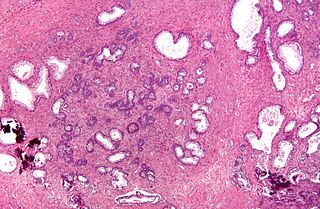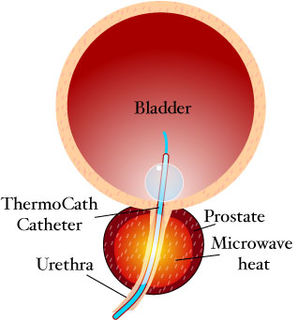Related Research Articles

Urology, also known as genitourinary surgery, is the branch of medicine that focuses on surgical and medical diseases of the male and female urinary-tract system and the male reproductive organs. Organs under the domain of urology include the kidneys, adrenal glands, ureters, urinary bladder, urethra, and the male reproductive organs.

The prostate is both an accessory gland of the male reproductive system and a muscle-driven mechanical switch between urination and ejaculation. It is found only in some mammals. It differs between species anatomically, chemically, and physiologically. Anatomically, the prostate is found below the bladder, with the urethra passing through it. It is described in gross anatomy as consisting of lobes and in microanatomy by zone. It is surrounded by an elastic, fibromuscular capsule and contains glandular tissue as well as connective tissue.

Benign prostatic hyperplasia (BPH), also called prostate enlargement, is a noncancerous increase in size of the prostate gland. Symptoms may include frequent urination, trouble starting to urinate, weak stream, inability to urinate, or loss of bladder control. Complications can include urinary tract infections, bladder stones, and chronic kidney problems.

Serenoa repens, commonly known as saw palmetto, is the sole species currently classified in the genus Serenoa. It is a small palm, growing to a maximum height around 7–10 ft (2.1–3.0 m). It is endemic to the subtropical and tropical Southeastern United States, most commonly along the south Atlantic and Gulf Coastal plains and sand hills. It grows in clumps or dense thickets in sandy coastal areas, and as undergrowth in pine woods or hardwood hammocks.

Urinary retention is an inability to completely empty the bladder. Onset can be sudden or gradual. When of sudden onset, symptoms include an inability to urinate and lower abdominal pain. When of gradual onset, symptoms may include loss of bladder control, mild lower abdominal pain, and a weak urine stream. Those with long-term problems are at risk of urinary tract infections.

Transurethral resection of the prostate is a urological operation. It is used to treat benign prostatic hyperplasia (BPH). As the name indicates, it is performed by visualising the prostate through the urethra and removing tissue by electrocautery or sharp dissection. It has been the standard treatment for BPH for many years, but recently alternative, minimally invasive techniques have become available. This procedure is done with spinal or general anaesthetic. A triple lumen catheter is inserted through the urethra to irrigate and drain the bladder after the surgical procedure is complete. Outcome is considered excellent for 80–90% of BPH patients. The procedure carries minimal risk for erectile dysfunction, moderate risk for bleeding, and a large risk for retrograde ejaculation.

Prostatectomy as a medical term refers to the surgical removal of all or part of the prostate gland. This operation is done for benign conditions that cause urinary retention, as well as for prostate cancer and for other cancers of the pelvis.
Alpha-1 blockers constitute a variety of drugs that block the effect of catecholamines on alpha-1-adrenergic receptors. They are mainly used to treat benign prostatic hyperplasia (BPH), hypertension and post-traumatic stress disorder. Alpha-1 adrenergic receptors are present in vascular smooth muscle, the central nervous system, and other tissues. When alpha blockers bind to these receptors in vascular smooth muscle, they cause vasodilation.
Nocturia is defined by the International Continence Society (ICS) as “the complaint that the individual has to wake at night one or more times for voiding .” The term is derived from Latin nox, night, and Greek [τα] ούρα, urine. Causes are varied and can be difficult to discern. Although not every patient needs treatment, most people seek treatment for severe nocturia, waking up to void more than 2–3 times per night.
Transurethral needle ablation is a technique that uses low energy radio frequency delivered through two needles to ablate excess prostate tissue. A cystoscope/catheter deploys the needles toward the obstructing prostate tissue is inserted into the urethra directly through the penis under local anesthetic before the procedure begins. The energy from the probe heats the abnormal prostate tissue without damaging the urethra. The resulting scar tissue later atrophies, reducing the size of the prostate which in turn reduces the constriction of the urethra. It can be done with a local anesthetic on an outpatient basis. It takes about an hour to perform the procedure. It takes about 30 days for the ablated prostate tissue to resorb.
Saw palmetto extract is an extract of the fruit of the saw palmetto. It is marketed as a treatment for benign prostatic hyperplasia, but there is no clinical evidence that it is effective for this purpose.

A prostatic stent is a stent used to keep open the male urethra and allow the passing of urine in cases of prostatic obstruction and lower urinary tract symptoms (LUTS). Prostatic obstruction is a common condition with a variety of causes. Benign prostatic hyperplasia (BPH) is the most common cause, but obstruction may also occur acutely after treatment for BPH such as transurethral needle ablation of the prostate (TUNA), transurethral resection of the prostate (TURP), transurethral microwave thermotherapy (TUMT), prostate cancer or after radiation therapy.
Lower urinary tract symptoms (LUTS) refer to a group of clinical symptoms involving the bladder, urinary sphincter, urethra and, in men, the prostate. Although LUTS is a preferred term for prostatism, and is more commonly applied to men, lower urinary tract symptoms also affect women.

Transurethral microwave thermotherapy (TUMT) is one of a number of effective and safe procedures used in the treatment of lower urinary tract symptoms caused by benign prostatic hyperplasia. It is an alternative treatment to pharmacotherapy such as alpha blockers, transurethral resection of the prostate (TURP), transurethral needle ablation of the prostate, photoselective vaporization of the prostate and prostatic removal or prostatectomy.
GreenLight Laser Therapy uses a laser beam to remove prostate tissue. The laser treatment is delivered through a thin, flexible fiber, which is inserted into the urethra through an instrument called a cystoscope.

Prostatic artery embolization is a developing non-surgical technique for treatment of benign prostatic hypertrophy (BPH). Although there is increasing research on PAE, use of the technique remains at an incipient stage.

If medical treatment is not effective, surgery may need to be performed for benign prostatic hyperplasia.
Prostate steam treatment (Rezum), also called water vapor thermal therapy (WVTT), is a minimally invasive surgical procedure for men with lower urinary tract symptoms resulting from prostate enlargement. It uses injections of steam to remove obstructive prostate tissue from the inside of the organ without injuring the prostatic part of the urinary tube.
Prostatic urethral lift is a minimally invasive procedure for the treatment of benign prostatic hyperplasia. This procedure can be done under local anesthesia in an outpatient consultation.
Finasteride/tadalafil, sold under the brand name Entadfi, is a fixed-dose combination medication used for the treatment of benign prostatic hyperplasia (BPH). It contains finasteride and tadalafil. It is taken by mouth.
References
- ↑ Pimentel MA, Nair SM, Gilling PJ (June 2016). "Aquablation - Early Clinical Results". Current Bladder Dysfunction Reports. 11 (2): 130–133. doi:10.1007/s11884-016-0364-5. S2CID 76102425.
- ↑ "Benign Prostatic Hyperplasia (BPH) Guideline - American Urological Association". www.auanet.org. Retrieved 2020-06-07.
- ↑ Gilling P, Reuther R, Kahokehr A, Fraundorfer M (June 2016). "Aquablation - image-guided robot-assisted waterjet ablation of the prostate: initial clinical experience". BJU International. 117 (6): 923–9. doi:10.1111/bju.13358. PMID 26477826. S2CID 3334967.
- ↑ MacRae C, Gilling P (December 2016). "How I do it: Aquablation of the prostate using the AQUABEAM system" (PDF). The Canadian Journal of Urology. 23 (6): 8590–8593. PMID 27995858.
- ↑ Hwang EC, Jung JH, Borofsky M, Kim MH, Dahm P, et al. (Cochrane Urology Group) (February 2019). "Aquablation of the prostate for the treatment of lower urinary tract symptoms in men with benign prostatic hyperplasia". The Cochrane Database of Systematic Reviews. 2019 (2): CD013143. doi:10.1002/14651858.CD013143.pub2. PMC 6373984 . PMID 30759311.